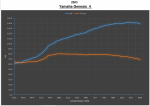NoWingsAttached
Unobtainium Member
- Joined
- May 21, 2006
- Messages
- 4,871
- Location
- Columbia, SC
- Aircraft
- Air Command Tandem w/ Arrow 100hp; GyroBee w/ Hirth 65hp; Air Command Tandem w/ Yamaha 150hp
- Total Flight Time
- >350
Mohawk Aero has purchased the complete set of dyno data sheets and informative articles for the Yamaha snowmobile 4-cycle series of engines, including 2-cylinder, 3-cylinder and 4-cylinder (what I call the YG2, YG3, and YG4, respectively), from 2003 through the 2017 model years.
We also purchased the official data (as required per racing regulations) for each manufacturer's sled raced in each year, starting in 2003, for the AMSNOW and Adirondack shootouts held in December in the northeast. This set of data included some very interesting information about the first year the YG4 was introduced.
The racing teams demanded that the YG4 be completely broken in prior to the race so that there would be no advantage to Yamaha for racing a brand new engine. I understand the meat of the article from my conversation with the technician who did the testing, but will wait until I read it thoroughly before telling you about it so that I don't make any mistakes in the re-telling of the story. For the moment, suffice it say that the dyno shop owner told me that choosing the YG4 engine for an aircraft conversion kit is/was the most excellent choice of all engines he's ever tested, bar none, in his professional opinion.
We now also have the technical data you would want before spending your valuable time and money on any mods such as turbos, intake plenums (silencers), tuning, exhaust, mufflers, different boost setups, cams and cam timing, fuel injection tweaks, etc.
As I pour through this impressive tome of definitive information I will be happy to post some highlights and basic information. Stay tuned, I may be back-pedaling on prior YG4 claims, and I may be posting some stuff you hadn't expected concerning the YG3's etc.
Meanwhile, feel free to ask anything you like and I'll try to dig up an answer for you.
We also purchased the official data (as required per racing regulations) for each manufacturer's sled raced in each year, starting in 2003, for the AMSNOW and Adirondack shootouts held in December in the northeast. This set of data included some very interesting information about the first year the YG4 was introduced.
The racing teams demanded that the YG4 be completely broken in prior to the race so that there would be no advantage to Yamaha for racing a brand new engine. I understand the meat of the article from my conversation with the technician who did the testing, but will wait until I read it thoroughly before telling you about it so that I don't make any mistakes in the re-telling of the story. For the moment, suffice it say that the dyno shop owner told me that choosing the YG4 engine for an aircraft conversion kit is/was the most excellent choice of all engines he's ever tested, bar none, in his professional opinion.
We now also have the technical data you would want before spending your valuable time and money on any mods such as turbos, intake plenums (silencers), tuning, exhaust, mufflers, different boost setups, cams and cam timing, fuel injection tweaks, etc.
As I pour through this impressive tome of definitive information I will be happy to post some highlights and basic information. Stay tuned, I may be back-pedaling on prior YG4 claims, and I may be posting some stuff you hadn't expected concerning the YG3's etc.
Meanwhile, feel free to ask anything you like and I'll try to dig up an answer for you.
Last edited:


